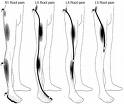Sciatic Nerve Pain or Sciatica
Sciatic nerve pain can make everyday activities such as walking, sitting and standing difficult. Sciatic nerve pain is a periodic severe pain that occurs throughout your legs, stemming from your lumber spine and goes into your gluts ( butt muscles) and even down into your legs. Sciatica is the secondary process created by sciatic nerve pain. It is common for a patient experiencing chronic low back pain (CBP) to develop sciatic nerve pain resulting in sciatica. Fortunately with proper maintenance, sciatica rarely return.
If you would like a FREE trial of the Infrex Plus unit in the convenience of your home or office just click here, or call us at 800-937-3993 to discuss any questions you have and how we can help. No obligation, no cost to you.
The extreme discomfort of chronic low back pain (CBP) results in the patient changing posture and adjusting seating/walking patterns to accommodate the pain they are experiencing. Over time the behavioral changes necessary for the patient to not be in pain often result in sciatica pain. The compression or “pinching” of the sciatic nerve due to these changes may inflame the nerve resulting in muscle compression.

Sciatica is the inflammation or irritation of the sciatic nerve which originates in your lower back and travels down your back to the hips into the back of the leg and extends to the lower leg. You have two sciatic nerves, one in each leg. Sciatica can be painful, with numbness and tingling in the gluteal and hamstring area. Untreated, the muscles begin to atrophy and weakness occurs.
Sciatica Pain Treatment
The sciatica pain slowly begins due to the lifestyle and habits necessary created by the pain of CPB. It is a prolonged onset of symptoms culminating in the secondary diagnosis of “sciatica” or “sciatic pain”. Sciatica pain treatment is aimed at maximizing mobility and independence. Treatment is conservative in as many as 50% of all cases and sciatic pain will greatly diminish or disappear within a month with supportive treatments and proper stretching. Sciatic nerve pain relief has been found using moist heat in combination with stretching exercises such as hip swings ( face down, heels together, hips flat as you swing your legs back and forth to stretch the muscles) .
The use of interferential therapy in conjunction with moist heat prior to beginning the exercising can greatly benefit the patient and the interferential therapy can provide long term carryover pain relief for days. Immediately after the interferential treatment it’s important to keep moving, not too fast, but move. If you sit for too long at a time, your muscles will tighten much quicker. If you’ve ever noticed that your pain is worse in the morning, after sleeping all night, then you realize as you get up and move then you are able to move with less pain whcih helps ease the pain. This is why moving is an important treatment for sciatica. During any exercise or movement, such as walking, the interferential mode should be switched over to TNS ( transcutaneous nerve stimulation ) and worn while exercising.
If you want more information prior to signing up or calling us then enjoy our video below.
Stop Muscle Pain, Disc Pain, Arthritis and Back Pain



